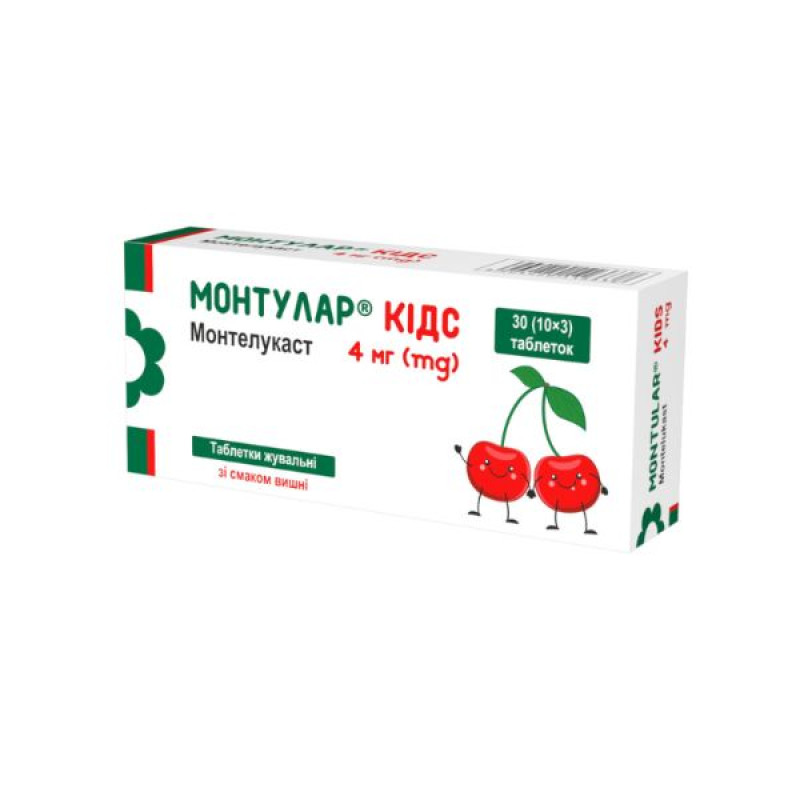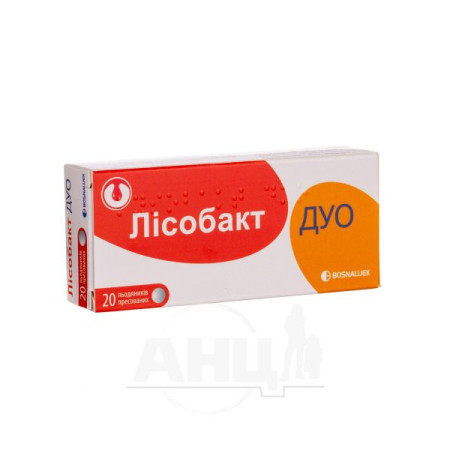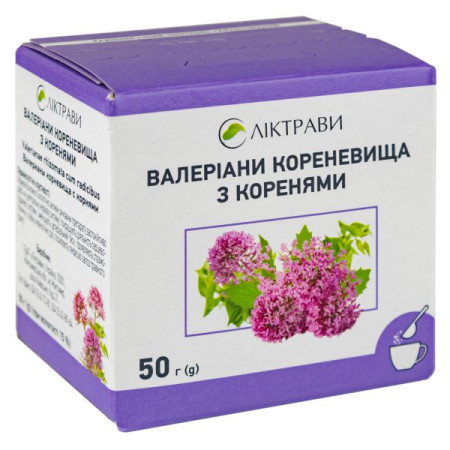Montular kids chewable tablets 4 mg No. 30

Instructions for Montular Kids Chewable Tablets 4 mg No. 30
Composition
active ingredient: montelukast sodium;
Each chewable tablet contains montelukast sodium equivalent to montelukast 4 mg;
excipients: microcrystalline cellulose (PH 112), hydroxypropylcellulose, croscarmellose sodium, red iron oxide (E 172), aspartame (E 951), Cherry flavoring 501027AP0551, mannitol (E 421), magnesium stearate.
Dosage form
Chewable tablets.
Main physicochemical properties: round biconvex tablets from light pink to pink in color without a shell with inclusions, smooth on both sides.
Pharmacotherapeutic group
Means for systemic use in obstructive airway diseases. Leukotriene receptor antagonists. ATX code R03D C03.
Pharmacological properties
Pharmacodynamics
Cysteinyl leukotrienes (LTC4, LTD4, LTE4) are potent inflammatory eicosanoids secreted by various cells, including mast cells and eosinophils. These important pro-asthmatic mediators bind to cysteinyl leukotriene receptors (CysLT) present in the human airways and induce airway responses such as bronchospasm, mucus secretion, increased vascular permeability, and increased eosinophil numbers.
Montelukast is an orally administered active compound that binds with high selectivity and affinity to CysLT1 receptors. In clinical studies, montelukast 5 mg inhibits bronchospasm induced by inhaled LTD4. Bronchodilation is observed within 2 hours after oral administration. This effect was additive to the bronchodilation induced by β-agonists. Treatment with montelukast inhibited both the early and late phases of antigen-induced bronchoconstriction. Montelukast reduces peripheral blood eosinophils compared to placebo in adults and children. In a separate study, montelukast significantly reduced airway eosinophils (as measured in sputum). In adults and children 2 to 14 years of age, montelukast reduced peripheral blood eosinophils and improved clinical control of asthma compared to placebo.
Pharmacokinetics
Absorption
Montelukast is rapidly absorbed after oral administration. After administration of 10 mg film-coated tablets to adults in the fasted state, the mean maximum plasma concentration (Cmax) was reached after 3 hours (Tmax). The mean oral bioavailability is 64%. The oral bioavailability and Cmax were not affected by the ingestion of a normal meal. Safety and efficacy have been demonstrated in clinical studies with the 10 mg film-coated tablets without regard to the time of food intake.
For the 5 mg chewable tablet, Cmax in adults was achieved 2 hours after administration in the fasted state. The mean oral bioavailability is 73% and decreases to 63% when taken with a standard meal.
After administration of 4 mg chewable tablets on an empty stomach in children aged 2 to 5 years, Cmax is reached 2 hours after dosing. The mean Cmax is 66% higher and the mean Cmin is lower than in adults after administration of 10 mg tablets.
Distribution
Montelukast is more than 99% bound to plasma proteins. The steady-state volume of distribution of montelukast averages 8 to 11 liters. In studies in rats with radiolabeled montelukast, passage across the blood-brain barrier was minimal. In addition, radiolabeled material concentrations in all other tissues were also minimal 24 hours after dosing.
Metabolism
Montelukast is extensively metabolized. Steady-state plasma concentrations of montelukast metabolites were not determined in studies using therapeutic doses in adults and pediatric patients.
Cytochrome P450 2C8 is the major enzyme in the metabolism of montelukast. In addition, cytochromes CYP 3A4 and 2C9 play a minor role in the metabolism of montelukast, although itraconazole (a CYP 3A4 inhibitor) did not alter the pharmacokinetics of montelukast in healthy volunteers given 10 mg of montelukast daily. In vitro studies using human liver microsomes indicate that therapeutic plasma concentrations of montelukast do not inhibit cytochromes P450 3A4, 2C9, 1A2, 2A6, 2C19, and 2D6. The contribution of metabolites to the therapeutic effects of montelukast is minimal.
Breeding
The plasma clearance of montelukast in healthy adult volunteers averages 45 mL/min. After oral administration of radiolabeled montelukast, 86% is excreted in the feces within 5 days and less than 0.2% in the urine. This, together with the oral bioavailability of montelukast, indicates that montelukast and its metabolites are almost entirely excreted in the bile.
No dose adjustment is necessary for patients with mild to moderate hepatic impairment. Studies in patients with renal impairment have not been conducted. Since montelukast and its metabolites are excreted in the bile, dose adjustment is not considered necessary for patients with renal impairment. There are no data on the pharmacokinetics of montelukast in patients with severe hepatic impairment (Child-Pugh score greater than 9).
A decrease in plasma theophylline concentrations has been observed at high doses of montelukast (20 and 60 times the recommended adult dose). This effect is not observed at the recommended dose of 10 mg once daily.
Indication
As add-on treatment for bronchial asthma in patients aged 2 to 5 years with mild to moderate persistent asthma inadequately controlled with inhaled corticosteroids, as well as with inadequate clinical control of asthma with short-acting β-adrenergic agonists used as needed.
As an alternative treatment to low-dose inhaled corticosteroids for patients aged 2 to 5 years with mild persistent asthma who have not had a recent history of serious asthma attacks requiring oral corticosteroids and who are unable to use inhaled corticosteroids (see section 4.2).
Prevention of asthma, the dominant component of which is exercise-induced bronchospasm, in patients aged 2 to 5 years.
Relief of symptoms of seasonal and perennial allergic rhinitis. Since the benefit of montelukast in patients with allergic rhinitis may not outweigh the risk of neuropsychiatric symptoms (see section "Special warnings and precautions for use"), Montular® Kids should be used as a reserve drug in patients with inadequate response to or intolerance to alternative therapy.
Contraindication
Hypersensitivity to any of the components of the drug.
Interaction with other medicinal products and other types of interactions
Montelukast can be administered with other drugs commonly used for the prevention or long-term treatment of asthma. In drug-drug interaction studies, the recommended clinical dose of montelukast had no clinically significant effect on the pharmacokinetics of the following drugs: theophylline, prednisone, prednisolone, oral contraceptives (ethinylestradiol/norethindrone 35/1), terfenadine, digoxin, and warfarin.
In patients receiving concomitant phenobarbital, the area under the concentration-time curve (AUC) for montelukast was decreased by approximately 40%. Since montelukast is metabolized by CYP 3A4, 2C8, and 2C9, caution should be exercised, especially in children, when the drug is administered concomitantly with inducers of CYP 3A4, 2C8, and 2C9, such as phenytoin, phenobarbital, and rifampicin.
In vitro studies have shown that montelukast is a potent inhibitor of CYP 2C8. However, data from a clinical drug interaction study involving montelukast and rosiglitazone (a marker substrate representing drugs primarily metabolized by CYP 2C8) have shown that montelukast is not an inhibitor of CYP 2C8 in vivo. Therefore, montelukast does not significantly affect the metabolism of drugs metabolized by this enzyme (e.g., paclitaxel, rosiglitazone, and repaglinide).
In vitro studies have shown that montelukast is a substrate of CYP 2C8 and, to a lesser extent, 2C9 and 3A4. In a clinical drug interaction study with montelukast and gemfibrozil (an inhibitor of CYP 2C8 and 2C9), gemfibrozil increased the systemic exposure of montelukast by 4.4-fold. No dose adjustment of montelukast is required when used concomitantly with gemfibrozil or other potent inhibitors of CYP 2C8, but the physician should be aware of the increased risk of adverse reactions.
Based on in vitro studies, no clinically significant interactions are expected with less potent CYP 2C8 inhibitors (e.g., trimethoprim). Coadministration of montelukast with itraconazole, a potent CYP 3A4 inhibitor, did not result in a significant increase in systemic exposure to montelukast.
Application features
Patients should be advised that Montular® Kids for oral administration should not be used to treat acute asthma attacks and that they should always carry appropriate rescue medication with them. In the event of an acute attack, a short-acting inhaled β-agonist should be used. Patients should consult their doctor as soon as possible if they require more inhalations of short-acting β-agonists than usual.
Montelukast should not be abruptly substituted for inhaled or oral corticosteroid medications.
In isolated cases, patients receiving anti-asthma agents, including montelukast, may experience systemic eosinophilia, sometimes with clinical manifestations of vasculitis consistent with the so-called Churg-Strauss syndrome, which is treated with systemic corticosteroids. Such cases have sometimes been associated with a reduction in the dose or withdrawal of corticosteroid therapy. The possibility that leukotriene receptor antagonists may be associated with the development of Churg-Strauss syndrome cannot be ruled out or confirmed. Physicians should be aware of the possibility that patients may develop eosinophilia, vasculitic rash, worsening pulmonary symptoms, cardiac complications and/or neuropathy. Patients who develop such symptoms should be re-evaluated and their treatment regimen reviewed.
Montelukast treatment does not allow patients with aspirin-dependent asthma to use acetylsalicylic acid or other nonsteroidal anti-inflammatory drugs.
Neuropsychiatric reactions have been reported in adults, adolescents, and children taking montelukast (see Adverse Reactions). Patients and physicians should be alert to neuropsychiatric reactions. Patients and/or caregivers should be instructed to notify their physician if such reactions occur. Physicians should carefully evaluate the risks and benefits of continuing to use Montelukast if such reactions occur.
Excipients:
The drug Montular®Kids contains aspartame (E 951), a source of phenylalanine, which is dangerous for patients with phenylketonuria.
Ability to influence reaction speed when driving vehicles or other mechanisms
Montelukast has no or negligible influence on the ability to drive and use machines. However, patients have reported drowsiness or dizziness.
Use during pregnancy or breastfeeding
Pregnancy: Animal studies do not indicate harmful effects on pregnancy or embryonal/fetal development.
Available data from published prospective and retrospective cohort studies of montelukast use in pregnant women evaluating major birth defects in offspring have not established a drug-related risk. The available studies have methodological limitations, including small sample sizes, in some cases retrospective data collection, and inconsistent comparison groups.
Breast-feeding: Studies in rats have shown that montelukast is excreted in milk. It is not known whether montelukast is excreted in human milk.
Montelukast can be used during breastfeeding only if it is considered absolutely necessary.
Method of administration and doses
For oral administration. Tablets should be chewed before swallowing. The drug should be used in children under adult supervision.
Dosage
The recommended dose for children aged 2 to 5 years is 1 chewable tablet (4 mg) per day, taken in the evening. The drug should be taken 1 hour before or 2 hours after a meal. No dose adjustment is necessary for this age group.
General recommendations
As an adjunctive treatment for bronchial asthma in patients with mild to moderate persistent asthma.
The therapeutic effect of montelukast on asthma control is achieved within 1 day. Patients should be advised to continue taking montelukast even if asthma control is achieved, as well as during periods of asthma exacerbation.
No dose adjustment is necessary for patients with renal impairment or mild to moderate hepatic impairment. There are no data for patients with severe hepatic impairment. The dosage is the same for boys and girls.
As an alternative treatment to low-dose inhaled corticosteroids in mild persistent asthma.
Montelukast is not recommended as monotherapy for patients with moderate persistent asthma. Montelukast should be considered as an alternative to low-dose inhaled corticosteroids in children aged 2 to 5 years with mild persistent asthma only in patients who have not had a recent serious asthma attack requiring oral corticosteroids and who are unable to use inhaled corticosteroids (see section 4.3). Mild persistent asthma is defined as asthma symptoms occurring more than once a week but less than once a day, nocturnal symptoms occurring more than twice a month but less than once a week, and normal lung function between episodes. If adequate asthma control is not achieved, the need for additional or different anti-inflammatory therapy should be assessed at a later stage (usually within 1 month) based on a consistent asthma management regimen. Patients should be periodically assessed for asthma control.
Montelukast is indicated for the prevention of exercise-induced bronchospasm in patients 2 to 5 years of age, which may be the primary manifestation of persistent asthma requiring inhaled corticosteroids. Patients should be evaluated after 2 to 4 weeks of treatment with montelukast. If an adequate response is not achieved, additional or alternative therapy should be considered.
Use of montelukast depending on other asthma treatment.
When montelukast is used as add-on therapy to inhaled corticosteroids, it should not be abruptly substituted for inhaled corticosteroids (see section 4.4).
Relief of symptoms of seasonal and perennial allergic rhinitis.
To relieve the symptoms of allergic rhinitis, the time of taking montelukast is selected individually.
Children
The safety and efficacy of Montular® Kids, 4 mg chewable tablets, in children under 2 years of age have not been established. The drug is used in children aged 2 to 5 years.
Overdose
In chronic asthma studies, montelukast has been administered at doses up to 200 mg per day to adult patients for 22 weeks, and in short-term studies up to 900 mg per day for approximately one week, with no clinically significant adverse reactions.
Acute overdoses of montelukast have been reported in post-marketing experience and during clinical trials. These included doses in adults and children exceeding 1000 mg (approximately 61 mg/kg in a 42-month-old child). The clinical and laboratory data were consistent with the safety profile in adults and children. In most cases of overdose, no adverse reactions were reported.
Symptoms.
The most frequently observed adverse reactions were consistent with the safety profile of the drug and included abdominal pain, drowsiness, thirst, headache, vomiting, and psychomotor hyperactivity.
Treatment.
There is no specific information on the treatment of overdosage with montelukast. It is not known whether montelukast is removed by peritoneal dialysis or hemodialysis.
Adverse reactions
The incidence of adverse reactions to montelukast (4 mg chewable tablets or granules) was evaluated in clinical trials involving 851 children with persistent asthma aged 2 to 5 years and 1038 children with intermittent asthma aged 6 months to 5 years.
In two placebo-controlled studies (one 12-week study; n = 461 and one 48-week study; n = 278) in children 2 to 5 years of age treated with montelukast, the most commonly observed adverse reactions (≥1/100 to <1/102%) were abdominal pain and thirst. The incidence of these events was higher than in the placebo group.
In clinical studies with prolonged treatment of children aged 2 to 5 years for at least 3 months (n = 502), 6 months or more (n = 338) and 12 months or more (n = 534), the safety profile did not change.
Post-marketing period
Adverse reactions reported during post-marketing experience are listed by system organ class and by special terms (see table). Frequencies are based on clinical trial data.
| Organ systems | Adverse reactions | Frequency* |
| Infections and infestations | Upper respiratory tract infections** | Very often |
| Blood and lymphatic system disorders | Tendency to increase bleeding | Rarely |
| Thrombocytopenia | Very rare | |
| On the part of the immune system | Hypersensitivity reactions, including anaphylaxis | Infrequently |
| Eosinophilic infiltration of the liver | Very rare | |
| From the psyche | Sleep disturbances (including nightmares, insomnia, somnambulism), anxiety, agitation (including aggressive behavior or hostility), depression, psychomotor hyperactivity (including irritability, restlessness, tremor§) | Infrequently |
| Attention deficit, memory impairment, tics | Rarely | |
| Hallucinations, disorientation, suicidal thoughts and behavior (suicidality), obsessive-compulsive disorder, dysphemia | Very rare | |
| From the nervous system | Dizziness, lethargy, paresthesia/hypoesthesia, convulsions | Infrequently |
| From the heart | Palpitation | Rarely |
| Respiratory, thoracic and mediastinal disorders | Nosebleed | Infrequently |
| Churg-Strauss syndrome (see section "Special warnings and precautions for use"), pulmonary eosinophilia | Very rare | |
| Gastrointestinal tract | Diarrhea***, nausea***, vomiting*** | Often |
| Dry mouth, dyspepsia | Infrequently | |
| Hepatobiliary system | Increased serum transaminase levels (ALT, AST) | Often |
| Hepatitis (including cholestatic, hepatocellular, and mixed liver disease) | Very rare | |
| Skin and subcutaneous tissue disorders | Rash*** | Often |
| Hematoma, hives, itching | Infrequently | |
| Angioedema | Rarely | |
| Erythema nodosum, erythema multiforme | Very rare | |
| Musculoskeletal and connective tissue disorders | Arthralgia, myalgia, including muscle spasms | Infrequently |
| Renal and urinary disorders | Enuresis in children | Infrequently |
| General disorders and adverse reactions caused by taking the drug | Pyrexia*** | Often |
| Asthenia/fatigue, malaise, edema | Infrequently | |
*Frequency is defined according to the frequency of reports in the clinical trial database: very common (≥1/10), common (≥1/100 to <1/10), uncommon (≥1/1,000 to <1/100), rare (≥1/10,000 to <1/1,000), very rare (<1/10,000). **This adverse reaction was observed with a frequency of “very common” in patients taking montelukast, as well as in patients taking placebo, during clinical trials. ***This adverse reaction was observed with a frequency of “common” in patients taking montelukast, as well as in patients taking placebo, during clinical trials. §This adverse reaction was observed with a frequency of “rare”. |
Reporting of suspected adverse reactions
Reporting of suspected adverse reactions after the marketing authorisation of a medicinal product is important. This allows for continuous monitoring of the risk/benefit balance of the medicinal product. Qualified healthcare professionals are asked to report any suspected adverse reactions according to the local reporting system.
Expiration date
2 years.
Storage conditions
Store in the original packaging at a temperature not exceeding 25 °C.
Keep out of reach of children.
Packaging
10 tablets in a blister, 3 blisters in a cardboard box.
Vacation category
According to the recipe.
Producer
Kusum Healthcare Pvt Ltd.
Location of the manufacturer and its business address
Plot No. M-3, Indore Special Economic Zone, Phase-II, Pithampur, Distt. Dhar, Madhya Pradesh, Pin 454774, India.
There are no reviews for this product.
There are no reviews for this product, be the first to leave your review.
No questions about this product, be the first and ask your question.













